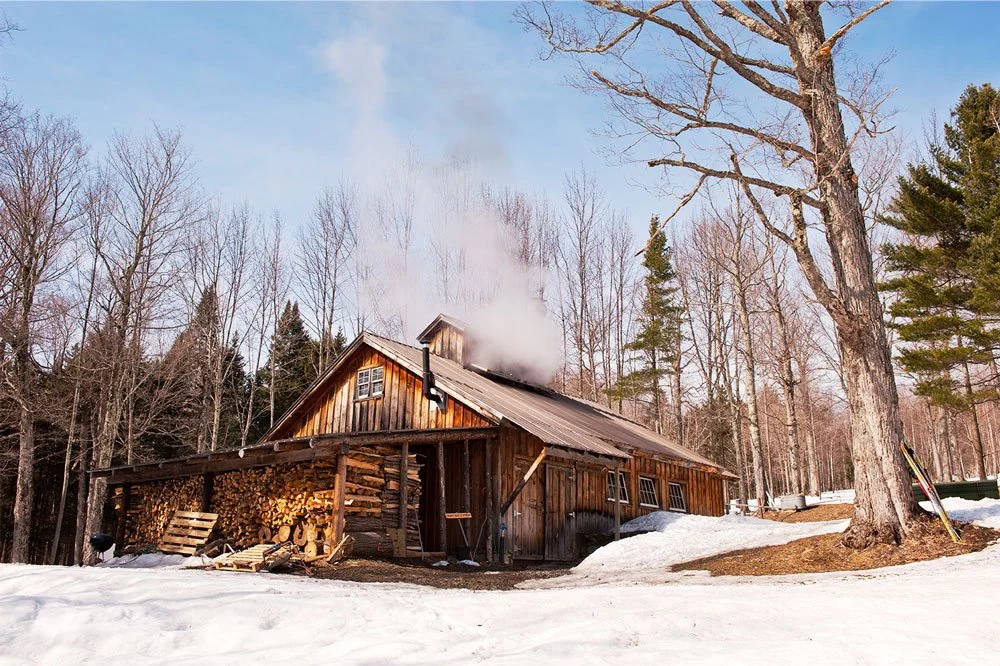Love and Maple Syrup
Last March I visited my first maple syrup farm. It was Grand Maple Farms in New Braintree, MA, a little west of Worcester. I had never really considered maple syrup to be a spring ingredient; aside from pouring over breakfast foods all year long, maple’s darker flavors, its somber and richer palate, always seemed to work best in in-season cocktails around the colder months of fall and winter. But maple syrup is, indeed, a spring ingredient in New England; most sugaring- off occurs just prior to the Spring Equinox, with a fresh batch of pure maple syrup ready for bottling by late March and early April (but this year, it started much earlier).
My interest in maple farming blossomed through my participation last winter in a cocktail-centric book club in which we read Robin Wall Kimmerer’s Braiding Sweetgrass. The subtitle of the book, “Indigenous wisdom, scientific knowledge and the teachings of plants,” sums up this treatise on the Native American relationship with vegetation. Kimmerer describes how various tribes used tree sugars to feed themselves through the end of the cold season just as the trees were feeding themselves in preparation for their yearly return to photosynthesis and new leaf growth. When there’s a combination of warm days and freezing nights, the sap begins flowing upwards, and that’s the time to capture some of it; once leaves and photosynthesis are established, the flow reverses to recharge the energy reserves in the roots.
Sugar shack photo courtesy of the Vermont Tourism Board.
After sap is harvested from the tree, it needs to be concentrated to make syrup. The older Native ways used a method called “freeze jacking,” removing a layer of ice—pure frozen water—from the top of the collected sap, helping to concentrate the liquid below. Later they added fire to the process and began boiling down the liquid. At Grand Maple Farms, like most maple operations in New England, farmers have upgraded from the old-school bucket gathering method to more modern tubing and pumping stations to more efficiently harvest the sugary liquid. To reduce boiling time, and thus fill the air with less evocative (but polluting) wood smoke, Grand Maple uses reverse osmosis instead of freeze jacking, which helps conserve energy by removing some of the sap’s water pre-boil; also, some sugar houses are opting for less romantic energy sources like natural gas, biofuel and electricity. The boiling time is still intensive, though: 40 gallons of raw maple sap reduces down to make just one gallon of syrup. These “cleaner” technological upgrades are necessary to speed up the process and turn a sustenance product into one that makes financial sense for local farmers.
My introduction to maple as an ingredient used in cocktails was perhaps by way of Misty Kalkofen’s Fort Washington Flip, named after the ruins of a Colonial- era fortification near the bar where she created it: Cambridge’s late, great Green Street Grill. She served it back in 2007 as part of an egg-themed Easter drinks menu, and I still make that recipe for bar guests who want something hearty to end their night. But maple syrup as a cocktail ingredient had been popular as far back as the late 1910s, with the best known classic of that era being the Applejack Rabbit. Mid-century maple even found its way into Tiki drinks like the Volcano Bowl, but its use, as demonstrated by Misty’s drink, blossomed in the most recent cocktail renaissance where it’s become popular in shaken drinks (like Sours and Daiquiris) and stirred ones, too, from Manhattans to Old Fashioneds.
The key to making great cocktails with maple is to start with great maple syrup. Do not confuse the real stuff with cheap pancake syrup. The real stuff, derived from tree sap, is boiled down and caramelized to enhance rich, roasted natural flavors, like vanilla, dried fruit and caramel; the artificial stuff is just high-fructose corn syrup gussied up with artificial flavors, color and preservatives. Maple’s darker flavors are a perfect match for aged spirits such as whiskey, as seen in my Old Fashioned riff, the Evening in a Sugar Orchard. But its rich tree essence also complements tequila and other agave spirits’ vegetal aspect, as in in my Margarita riff, the Maple Sugar Moon. And maple is a great friend to gin, with its juniper-derived pine tree notes, highlighted in the Circles and Seasons. The recipes for these three drinks are easily mixed up at home to celebrate this year’s maple syrup bounty.
To turn your maple cocktail making into more of an adventure, first go visit one of the maple farms here in Massachusetts to shop for supplies. The Massachusetts Maple Producers Association’s website (massmaple. org) has a map of various farms and sugar shacks where you can buy local syrup, as well as other tasty maple products like candies and creams. Some farms, like Grand Maple in New Braintree, Hollis Hills Farms in Fitchburg and Land’s Sake Farm in Weston, will talk you through the process and show off their sugar house equipment at special springtime events so that you can walk away with a sense of history and agricultural pride along with a jug of amber goodness. Even here in Somerville, about a mile from my home, there is a small annual boil using local maple sap collected on the campus of Tufts University and processed at the Somerville Community Growing Center facility; the organizers of the harvest and boil make a nod to the Wampanoag Indian tribe who used this land to make maple syrup centuries before. And with that, cheers to this tasty harbinger of spring!
This story appeared in the Spring 2023 issue.





